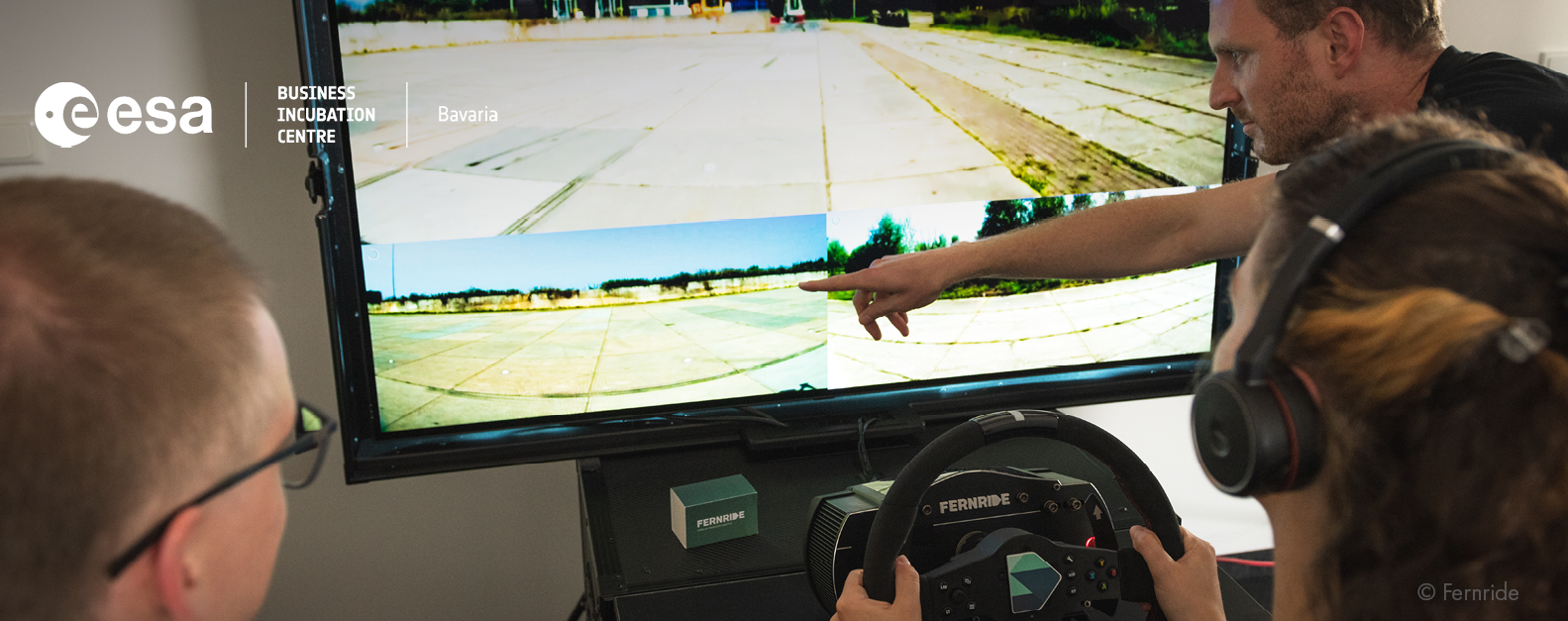Fernride wants to actively shape the automated future and the role of humans in it. The company automates processes in logistics with driverless, sustainable machines and integrates them into existing client processes. On request, Fernride controls the vehicles remotely, a technology that is essential in the space sector. An interview with Hendrik Kramer, CEO and co-founder of Fernride.
Who is Fernride and what sets you apart from your competition?
Fernride is actively shaping the automated future and the role of humans in it. We combine the human skills of drivers from the office, called teleoperators, with autonomous driving technology in a scalable platform. Our clients can thus already take the next step in automating their processes today and make this transition seamlessly. Our unique offer is very much tailored to the logistics sector and the technology can be integrated into existing operating procedures, so there are only partial overlaps with competitors on the German market. While some of our competitors promise autonomous lorries in the future, we are already driving today. We not only deliver the technology but also act as a partner to our logistics clients on the path towards automation.
What interest do you have in space technology?
Successes in space are based on remote control technology. We are doing the same for vehicles on four wheels – with teleoperation. Like in “Houston”, it is crucial for us to establish a reliable connection between the control centre and vehicle and exchange data in real time. We are pushing the boundaries of what is technically possible and setting new standards. Like in space, our platform offers a future-proof, scalable service and maximum safety by combining the strengths of man and machine.
Why exactly the logistics sector and could other mobility applications also benefit from your service?
The industry is already heavily automated in warehouses and logistics centres. Meanwhile, processes are still controlled manually in yards and on the road. At the same time, the logistics sector has a huge need for action, for instance due to a high level of efficiency pressure and the growing shortage of drivers. Logistics offers excellent conditions for making use of the technology today: The processes are relatively simple and can be automated quickly. Within fenced production facilities, the traffic scenarios and legal framework conditions are less complex than on the road. And the processes that need to be performed are clearly structured. For us, logistics thus offers the ideal environment to enter the market, where our technology can quickly demonstrate its added value. From there, an expansion into other mobility sectors is quite possible and logistics is only the beginning: As our technology can be used independently of vehicles, the logical next step is naturally to also use it in long-haul transport (e.g. hub to hub) on the road or other mobility applications. The experiences that we are currently gaining at business premises will help us to realise scalable, fully automated driving on public roads more quickly. We want to take such next steps in two to three years.
Sounds like a great deal of responsibility for your teleoperators. How do you ensure that they have a good working environment while also offering availability on demand for your clients?
The work of a teleoperator is just as responsible as that of a conventional long-distance lorry driver. The teleoperator always controls just one truck at once, but can switch between up to 50 vehicles on a business premise – depending on where the teleoperator is needed. Similar to air traffic controllers, they thus manage a whole fleet in parallel and can make the process more efficient as, for instance, they are not affected by waiting times for loading and unloading. It goes without saying that this remote control of vehicles involves great responsibility: the job is thus (so far) performed by experienced lorry drivers who enjoy additional training with us including special training sessions. In practice, we have a safety concept that, among other things, includes a reliable communicative connection from teleoperators to the truck and surrounding area. Our technology ensures connectivity and guarantees constant monitoring. This has already been demonstrated in pilot projects. We even take into account the health of the teleoperators: the workstations are designed ergonomically, similar to the cab of a lorry. We take feedback from the drivers into consideration in continuous further development, but are proud that we have already created an ergonomic and comfortable monitor-based workplace for them.
How scalable is your concept?
Our concept is based on the vision of actively shaping the role of humans in an automated world – a world that is safer, more inclusive, more sustainable and more productive. A scalable, future-proof platform from one source that evolves from remote driving to complete autonomy is thus essential. Our vehicle-agnostic technology can therefore be applied to any vehicle and any use case throughout the entire logistics supply chain – and beyond – without any problems.
What, in your opinion, must be done politically to successfully integrate self-driving vehicles into everyday life?
With the world’s first legal framework for automated driving, the German federal government took a big step in the right direction in 2021. The law fundamentally governs and permits the use of autonomous vehicles in defined operating areas, such as in transport between logistics terminals. Technical supervision must also monitor the journeys – and so far only our technology can offer this remote control and supervision of a driverless vehicle. In our view, a law of this kind was long overdue, as one of the most important tasks in the long-term establishment of autonomous driving is creating trust in a technology such as ours. Politics must give companies like us a chance to show that gradual automation means more and not less safety – especially as none of the major automobile manufacturers can afford to attract negative headlines relating to autonomous driving.
Which mobility concepts in the coming decade excite you the most and will there continue to be a need for Fernride’s teleoperation?
In general, like everyone, we are eager to see whether and when some companies’ great promises will become a reality. Revolutions are constantly being announced, particularly concerning the “last mile” and passenger transport. But there are still a few years to go before these become a reality. Let’s be honest, what kind of parents would put their child on a school bus without a driver? A great deal of trust and acceptance needs to be established before that happens. This is why we are also not worried that the need for our technology will suddenly disappear completely, as it is essential when developing exactly this trust.
What would you be doing today if you hadn’t founded Fernride?
Fernride is the result of a shared vision: redefining the role of humans in an automated world. If Fernride hadn’t been founded, we would presumably have founded a different company that would have shifted to this vision. We are living in a time of fundamental change and automation and digitalisation will revolutionise mobility and thus our coexistence. We want to help shape this change and seize this opportunity.





Comments are closed.